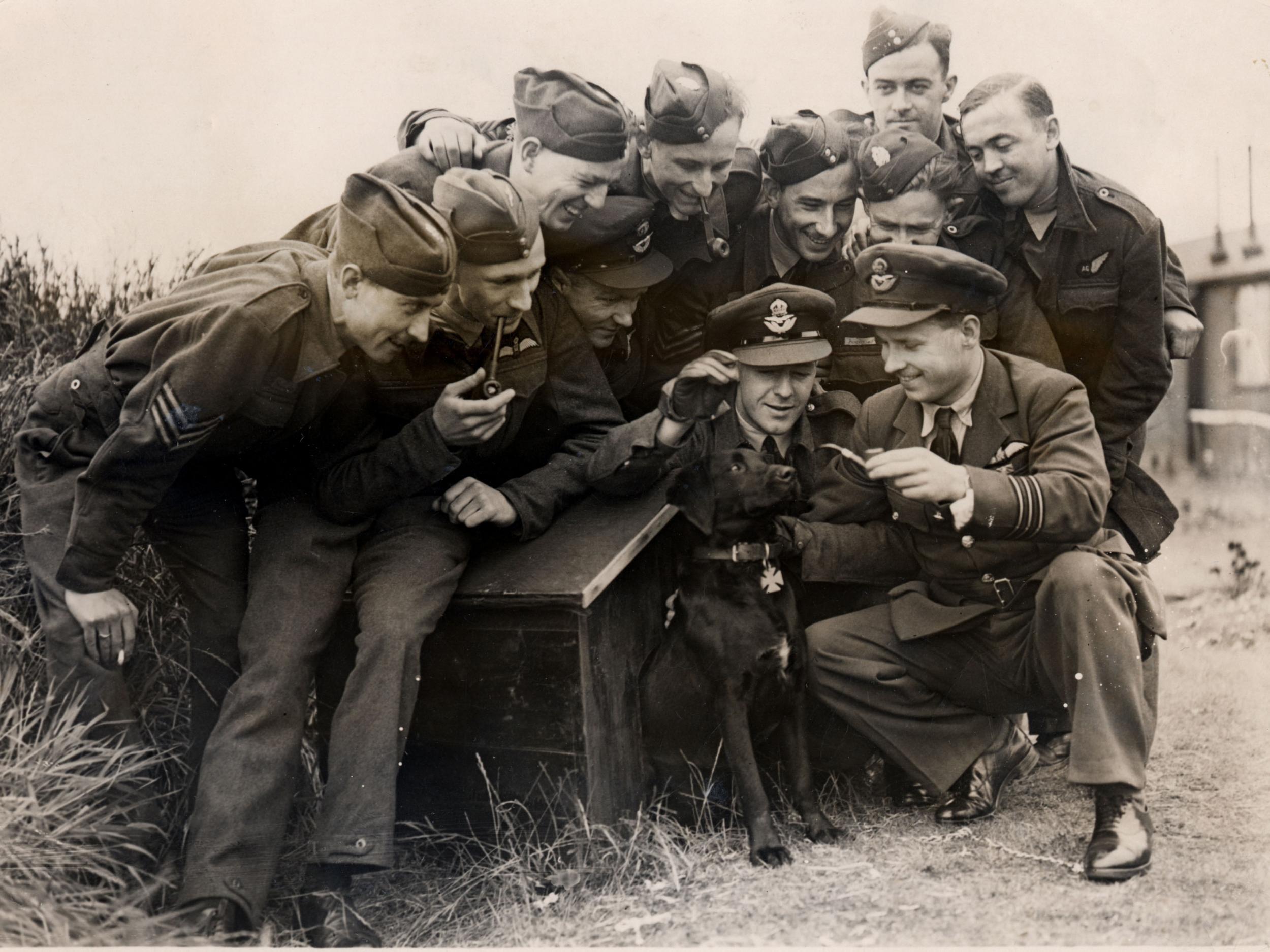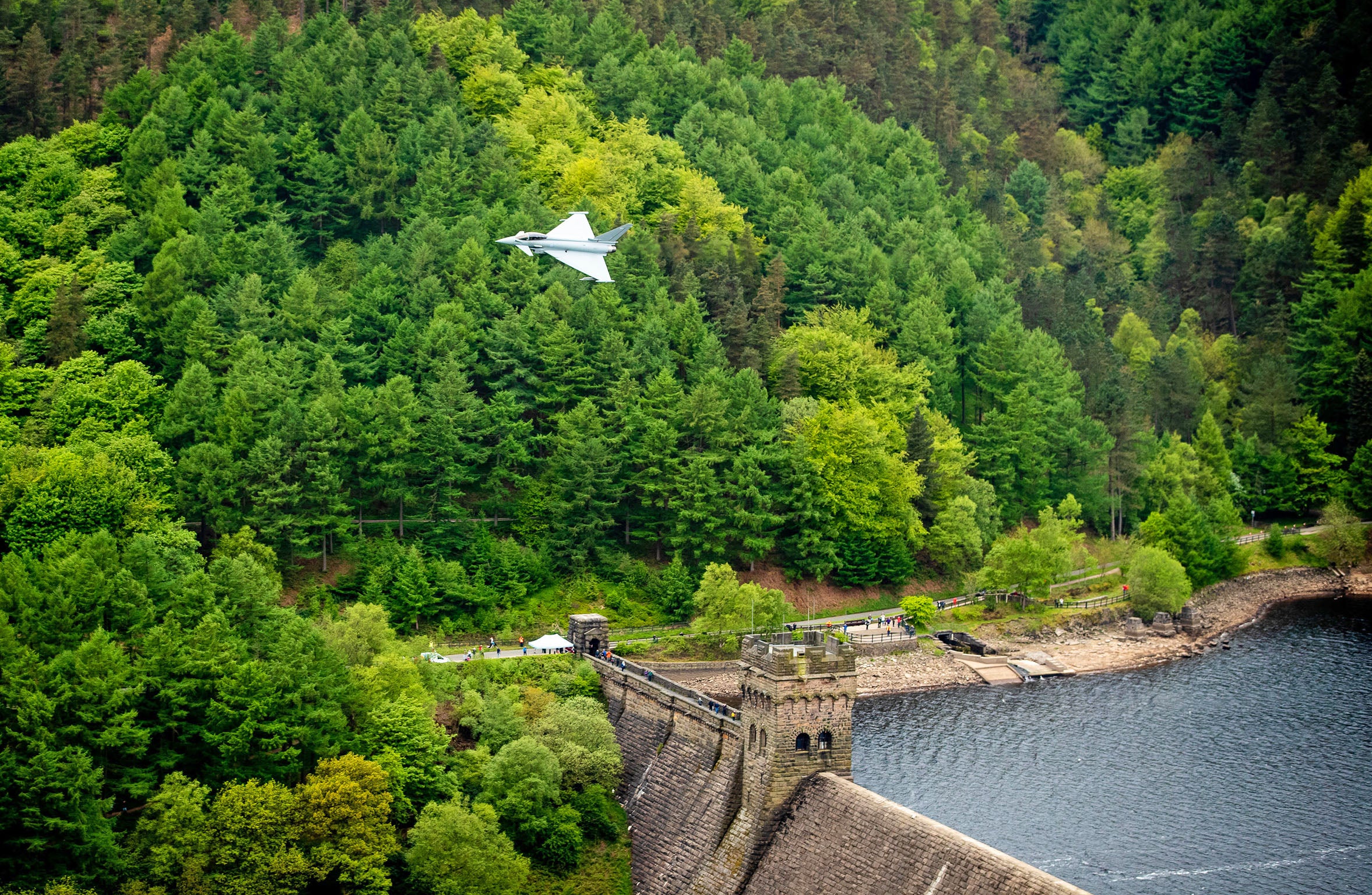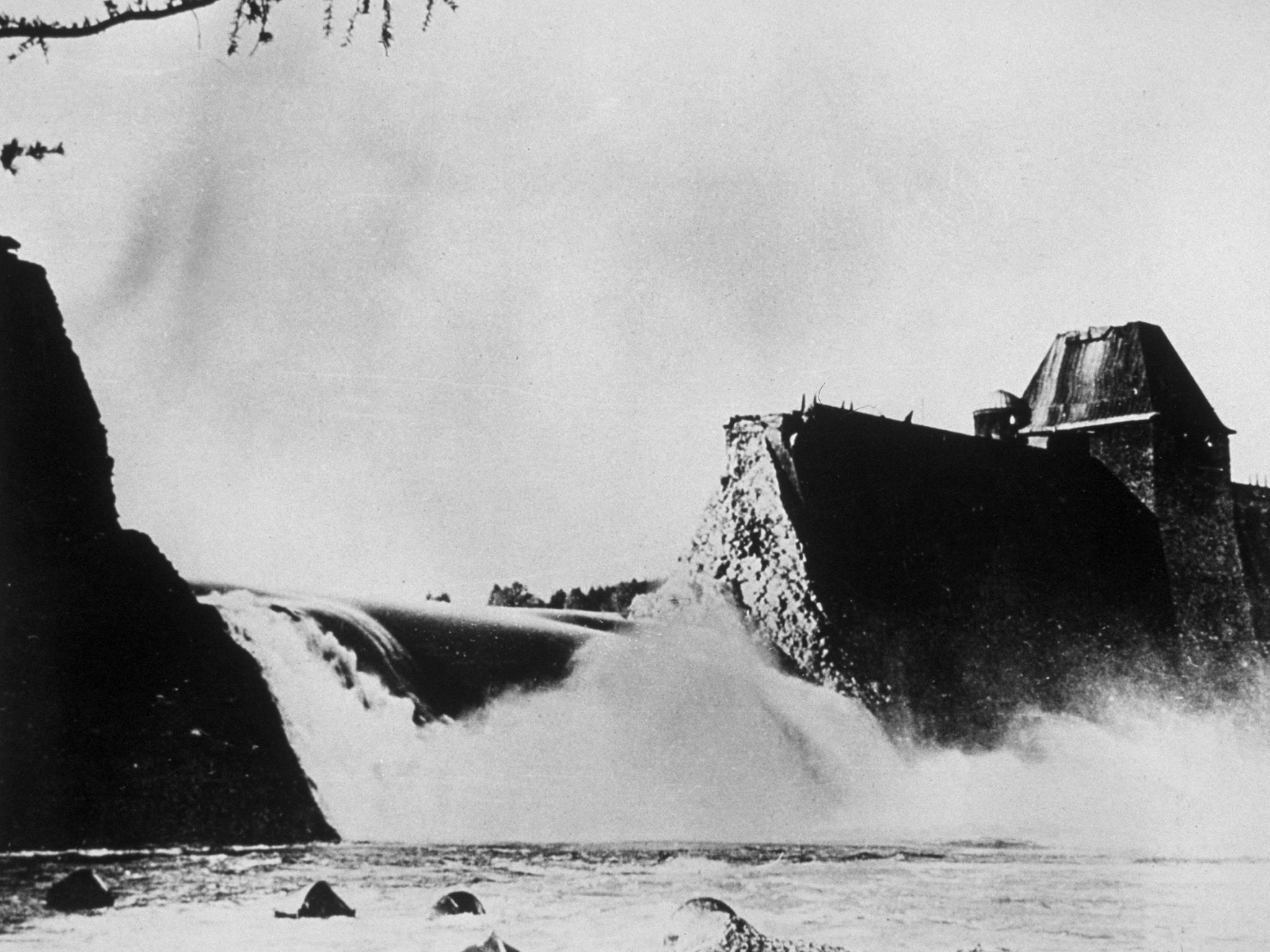The Dambusters: 80 years on from the legendary Second World War raid
The intertwining of science and propaganda, carried on the back of a remarkably audacious attack into the heart of Germany, means Operation Chastise holds a singular place in the British national consciousness, writes Mick O’Hare


His Lancaster was flying low over the water, at an almost impossible angle to its intended target. On the 10th and final attempt bomb-aimer George “Johnny” Johnson released the weapon. It struck the Sorpe Dam dead centre, exploding behind the earthen dam wall exactly as intended. But the structure remained intact as the aircraft soared upwards, narrowly avoiding a nearby church steeple.
Johnny Johnson MBE was the last of the Dambusters. He died on 7 December 2022, aged 101, the final survivor of the most daring of Second World War operations. Although his strike was unsuccessful, two other dams deep in Nazi Germany’s industrial heartland were breached that night in 1943. It was the first time the RAF’s most secret weapon had been deployed. The “bouncing bomb” had lived up to its name and had worked perfectly.
Johnson and his RAF comrades were immortalised in the eponymous movie released in 1955, starring Richard Todd as Wing Commander Guy Gibson, the mission’s commanding officer. If, inexplicably, you’ve never seen the film, you’ll almost certainly know its title theme.
It tells the story of Operation Chastise. Nineteen RAF Lancaster bombers and 133 aircrew of 617 Squadron were dispatched to destroy the hydroelectric dams of the Ruhr valley in North Rhine-Westphalia, which were powering factories and mines supporting the Nazi war effort. Many of the airmen died and some historians have argued they achieved only limited success, yet the story has become one of legend – British ingenuity and derring-do, taking on the Third Reich in its own backyard.
But, as the 80th anniversary of the raid approaches on 16 and 17 May, there are perhaps two other reasons why the mission should be commemorated, beyond that stirring music and the heroics of Gibson and his squadron drawn from across the Commonwealth. And those two reasons are intimately linked.
First, the Dambusters raid was a triumph of science. Without the team of engineers led energetically by inventor Barnes Wallis, the attack simply wouldn’t have been possible, however courageous and accomplished the airmen. It was idiosyncratic genius at its best.
Second, the sublime science that made the raid possible provided the British with a huge propaganda coup. In terms of public morale – and the converse effect on the German population – this far outweighed what was achieved, successful or otherwise.

What has given the raid its legendary status is, of course, the means by which it was executed. Conventional bombing in the 1940s wasn’t accurate enough to destroy the dams, and waterborne torpedoes would have had no success because protective nets stretched beneath the waterline.
So Wallis, inspired both by watching children skimming stones across a lake and the 16th-century Royal Navy tactic of “bouncing” cannon balls off the surface of the sea, conceived the idea of bombs with a spinning outer casing, which would allow them to “bounce” atop the water until they struck the dam.
And while the now-familiar term “bouncing bomb” has passed into popular usage, in truth it is something of a misnomer. As Wallis himself knew, they effectively skimmed or ricocheted off the water surface. “And,” adds Peter Johnston, curator and historian at the Imperial War Museum, Duxford, “they weren’t actually bombs, they were mines.”
Their construction would require quite extraordinary engineering and technical knowledge, and their delivery would rely on exceptional skills. The Lancasters would need to fly at exactly the correct altitude, dangerously low over the water, before releasing the bombs at the optimum distance.
“The sheer ingenuity is why we remember the raid today, and the sacrifice of the men involved,” says Johnston. “It wasn’t the most destructive, prolonged or successful raid. But the expertise of the designer and the aircrew should be lauded, whatever we might think about the horror of war. It’s not being triumphalist to acknowledge the achievement. And it was all planned under wartime conditions in a matter of months from theory to execution. An astonishing rate of development.”
Wallis first considered the concept in an academic paper of April 1942. “He wasn’t the first to come up with the idea,” says Johnston. “But he was the one who carried it through,” experimenting in his back garden using marbles skimming across a rain-filled bathtub. Air Chief Marshal Ralph Cochrane and Arthur “Bomber” Harris of Bomber Command were intrigued and Wallis was advised to start work. One year later his bombs – code named Upkeep – would be on their way to the Ruhr.
The intervening months, however, were suffused with numerous setbacks. Wallis had calculated the bombs should hit the water at a perfect angle (about 7 degrees) and speed (232mph) ensuring the water would push back on the bomb casing, forcing it into the air.
At first Wallis experimented with spherical bombs, but these proved unpredictable, spinning off at dangerous angles. Even worse the casings tended to break on impact. Tests in December 1942 at Chesil Beach in Dorset and later at Reculver in Kent didn’t offer much hope.

It was at this point Wallis realised a cylindrical, barrel-like bomb without the spherical casing might work better. He also figured out that if he applied backspin, just as a tennis player might do to the ball to confuse their opponent, that would create a gyroscopic action to stabilise the trajectory.
He was also exploiting what is known as the Magnus effect which counters the pull of gravity and allowed the bomb to skim the water’s surface. His knowledge of physics was so deep that he realised if he placed the majority of the bomb’s weight at the outer edges of the cylinder, giving it greater momentum, it would be more difficult for it to be knocked off its axis.
“The bombs had to strike the dams at just the right level,” explains Johnston. “Too far away and they would sink too soon, too close and they would simply bounce over.”
In a final twist of brilliance, Wallis figured out that backspin also ensured the bomb would sink when it stopped bouncing just before the dam, and travel down its inside wall, where at a depth of 30 feet hydrostatic pressure would trigger the explosives, destroying the dam at its most vulnerable point.
The Lancasters were modified to house a rotating motor in their bomb bays, which would spin the bombs to the correct speed.
But other practical considerations were stymieing progress. During further experiments using a scale model of the Ruhr dams at the Building Research Establishment in Watford, Wallis realised that the amount of explosive each bomb would have to carry to destroy the structures would weigh 13 tons. Put inside an 18-ton casing, it was far more than a Lancaster could carry.
Wallis’s 31-ton giant would have to be scaled back to a more modest four tons, and more aircraft would be required in several attacks. He also deduced that a four-ton bomb could still be successful; enough to weaken the dam wall allowing the enormous pressure of water behind to do the rest.
But how low would the aircraft have to fly and at what speed? After returning to his garden bathtub and later using a large ship tank in Teddington, he had his figures. In bad news for Gibson and his crews, Wallis explained they would be flying at 240mph only 60 feet above the water – and at night. Unwavering concentration and pinpoint navigation would be paramount.
In March, mere weeks before the mission, 617 Squadron had been given official notice that it had been selected to carry out the attack, although the targets remained top secret. The squadron was sent to the Derwent Reservoir in Derbyshire to try out Wallis’s updated hardware and mathematics.

“It even looked like the actual target, the dam on the Möhnesee,” says Johnston. “It was the perfect training location.” Night after night they flew at low altitude, using a system of lights projected on the water surface to gauge their height. “They discovered flying at 60 feet was more difficult to master than using the actual weapon,” says Johnston.
Locals became used to sleepless nights as the aircraft droned overhead, and farmers complained it affected milk production. But by late April the bombs – containing no explosives – were performing as they should and the pilots were confident. Only days remained before the raid.
The entire concept was inspired; an extraordinary scientific achievement involving the kind of research, experimentation and development that might have taken a lifetime, condensed into a single year.
Operation Chastise left RAF Scampton in Lincolnshire late in the evening of 16 May. It was a full moon and in mid-May the dams were at their fullest. The bombs were to be released about half a mile before the dam, bounce five or six times and then sink and explode. The targets were the Möhne and Sorpe Dams upstream from the Ruhr industrial zone, with the Eder Dam as a secondary target.
At 00.28 Gibson’s Lancaster swooped low over the water heading for the Möhne Dam, the first of 19 aircraft heading for their targets. By first light the following morning only 11 had returned. 53 aircrew – “That’s 42 per cent of the total,” says Johnston – were dead with three others captured. Some were shot down, some collided with power cables due to flying at such low altitude, another hit the sea. Barnes Wallis regretted this for the rest of his life.

Two dams were breached; a third – Johnny Johnson’s Sorpe target – remained intact. Some of the aircraft appeared to get lost in dense fog and it’s possible at one point the wrong dam was attacked. Nonetheless, immediate damage was appreciable. Bridges were washed away, farmland was flooded. Factories were destroyed, production hugely disrupted, and 1600 people drowned, many of them slave labourers, something else Wallis regretted. “They didn’t set out to kill anybody,” says Johnston. “But it was an inevitable consequence.”
Yet, by September the Germans had rebuilt the dams and factories, and production was again coming on-stream. Arguments have since raged over whether the raid, and its subsequent loss of life, had been worth it.
Many historians say it diverted vital resources from the German war effort into reconstruction, including neglecting Atlantic-coast defences for forthcoming D-Day. Others – including Arthur Harris who said he had seen nothing beyond a “spectacular operation” – argued it only served as a PR exercise to boost morale back home.
“It vexes historians,” admits Johnston. “And it was a strategic error of Bomber Command not to follow up the attack using conventional bombing to strike the dams while they were being reconstructed. That would have seriously affected German morale. But that doesn’t detract from the raid itself, which was never meant to win the war, but to provide a fillip by denting the Nazis’ industrial output.”
Which was good enough for the government. Successful or not it set about exploiting the extraordinary nature of the mission. The communications department of the War Office sprang into life. The BBC reported Secretary of State for Air, Sir Archibald Sinclair, calling the raid “a trenchant blow for victory”.
The front pages of the newspapers went further. A great feat was celebrated, the airmen becoming heroes overnight. “Floods roar down Ruhr Valley,” screamed the Daily Express. “Huns get a flood blitz,” proclaimed the Daily Mirror. The Daily Mail described how the whole Ruhr Valley was flooded, with “power stations, factories, villages and livestock swept away”.
While the Nazis counteracted with their own version of events, there was clearly only one winner in the propaganda war. The BBC and the press pushed the story for months with personal accounts from the airmen and observers appearing weekly.
On 22 June the Dambusters were back on the front pages. The surviving crew was honoured at Buckingham Palace with Gibson, only 24 years old, being awarded the Victoria Cross, Britain’s highest military award for bravery in the field. In total 34 medals were presented, a record for any single RAF mission. Colour photographs of Gibson were released – colour film was rare and expensive in 1943 – and afterwards Gibson would tour North America relating his story.
Tragically when he returned to operational duties the following year he was killed over the Netherlands. But his actions, and those of his squadron, had an extraordinary effect on British and allied morale in the years between Dunkirk and D-Day.
Historian Dan Snow wrote on the BBC’s website in 2013: “Propaganda, as Churchill knew so well, is as much a part of war as killing enemy soldiers. The most important impact of the Dambusters raid may indeed have been in convincing people on both sides that the Allies were winning, and that, often, is how wars are won and lost.”
It is because of the intertwining of science and propaganda carried on the back of a remarkably audacious attack into the heart of Germany that Operation Chastise holds such a singular place in the British national consciousness, says Johnston. “And,” he adds, “let’s not forget the movie, actually quite accurate and true to its source material. It uses some dramatic licence, but it was never meant to be a documentary. And, of course, the music was memorable.”
The romance of skilful, plucky airmen underpinned by British inventiveness taking on the Nazi war machine was beguiling. That narrative of the film The Dam Busters – legend or reality – is the narrative that has endured. Barnes Wallis might not have realised what he had set in motion, but the government and a willing media most certainly did. Cue rousing film score…
Join our commenting forum
Join thought-provoking conversations, follow other Independent readers and see their replies
Comments
Bookmark popover
Removed from bookmarks